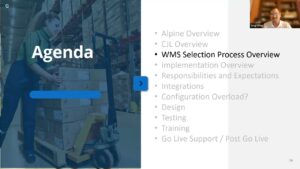The Warehouse Management System (WMS) market is currently experiencing significant growth, driven by the increasing need for efficient supply chain management and the rise of e-commerce, informing key WMS market trends. Companies are investing in advanced WMS solutions to enhance automation, improve inventory accuracy, increase throughput, and streamline operations. The integration of technologies like AI, machine learning, and IoT is becoming more prevalent, providing enhanced data analytics and predictive capabilities. Additionally, the shift towards cloud-based WMS is gaining momentum, offering scalability, flexibility, and lower upfront costs for businesses of all sizes.
To get a better understanding of WMS market trends and purchasing practices, Alpine’s Senior Director, David Meyers, recently joined a panel discussion of experts from enVista, Made4net, and Zion Solutions Group. They spoke in detail about the 2024 Gartner® Magic Quadrant™ for Warehouse Management Systems (WMS), what is driving investments in WMS solutions today, and the issues buyers are most concerned about. Here are a few key takeaways from that conversation.
1. The 2024 Gartner® Magic Quadrant™ for WMS remains a valuable resource for understanding the latest trends and top performers in the WMS market.
The Gartner WMS Magic Quadrant continues to provide a comprehensive analysis of the top vendors in the market based on their ability to execute and completeness of vision. By offering insights into WMS vendor’s strategic direction, product capabilities, and overall market performance, the report can help companies make informed decisions when selecting a WMS.
This year’s report offers a consolidated view and evaluation of the Warehouse Management System software market and an easy-to-use side-by-side comparison of 23 top solutions on the market. Highlights from the report include:
- Labor challenges and escalating costs are major factors motivating investment in WMS
- Seamless integration and optimization of workflows across all business stages are critical for WMS purchasers
- There is a rising trend towards cloud-based solutions in WMS implementations
- Modern WMS buyers demand software that offers easy and rapid customization to fit their specific needs
- Considerations such as technical architecture, total cost of ownership (TCO), and time-to-value are crucial
- Simplicity is highly valued by WMS buyers today
2. Adopting a cloud-based WMS can provide greater flexibility and scalability as your business grows.
Major WMS providers are adapting well to meet the demand for cloud services and scalability. New entrants to the market assume this as standard for their offerings. Still, potential buyers should scrutinize service level agreements (SLAs) for updates and control over upgrade processes, as they can have a significant impact on the overall running of the operation. As far as WMS market trends go, while on-premise solutions are becoming less common, they still have a place in several scenarios such as those with security concerns.
3. When determining if it’s time for a new WMS, there are key signals to watch for.
Most operations transition to a new WMS when the current system is out of support and requires extensive internal efforts to maintain. But those aren’t the only reasons to invest in a new WMS. Corporate mergers, technological advancements, business growth, and the need to stay relevant and attract employees also drive this decision. When it comes to determining whether investing in a new WMS is the right move, assessing the risks of not upgrading versus the benefits of a new system is essential.
4. Following best practices for selecting the right WMS vendor can help ensure you choose a vendor that meets your specific operational needs and long-term goals.
Meyers recommends beginning with a thorough requirements assessment. From there you’ll want to create a short list of vendors and engage in detailed vendor demos to evaluate fit. Look at core processes, critical business needs, and challenging scenarios as they relate to your specific operation. Vendor demos offer an opportunity to see how a solution addresses your unique business needs, not to see how the system works in a vacuum.
Key WMS Market Trends – Concluding Points
Selecting the right WMS is a pivotal decision that can define your company’s success for the next decade or more. Given the complexity of such a choice, there is a lot of due diligence that must go into the process, including determining the cost and potential ROI. Alpine’s experts with our Systems Practice are here to help with system justification, requirements definition, system selection, systems implementation services, work instruction & SOP development, and training. For more key takeaways from the 2024 Gartner Magic Quadrant for WMS, listen to the full panel discussion here. And, reach out if you need additional support selecting and implementing the right WMS for your operation.













